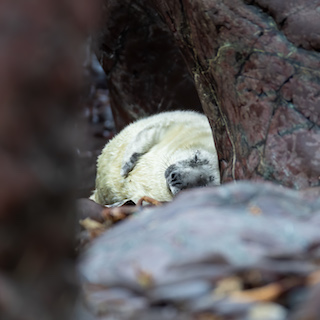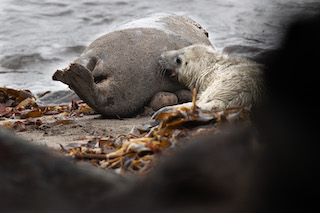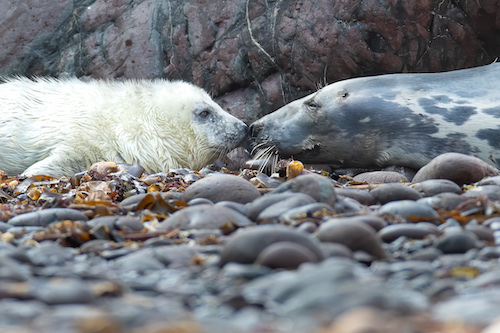 In the UK, Grey Seal pups are born between September and December.
In the UK, Grey Seal pups are born between September and December.
Photo: © Richard Birchett
Scientific name: Halichoerus grypus
Common name: Grey Seal
Other common names: North Atlantic Grey Seal, Horsehead Seal (the latter presumably derived from its longish snout)
Cornish name: Reun is the word for ‘seal’
Conservation status: IUCN Red List – Least Concern; protected in Europe under the EC Habitats Directive and Bern Convention; protected in Britain under the Conservation of Seals Act 1970.
 In Britain, the main season for Grey Seal pups to be born is from the autumn into early winter. Adult females congregate at rookeries – the name given to their pupping sites, nothing to do with rooks – and give birth to their familiar (and very fetching) white-furred young. Weighing around 14 kg at birth, a pup, nourished by its mother’s rich and fatty milk, can quadruple in weight within three weeks, after which its mother will leave it to cope on its own. Within this first three weeks of life, pups can be seen in the water with their mothers, learning to swim, but after weaning they must learn to fish on their own. Grey Seals spend significant periods of time ashore, and can easily tolerate drying out. Both male and female seals can be seen at the rookeries, as the males come ashore to breed with the females.
In Britain, the main season for Grey Seal pups to be born is from the autumn into early winter. Adult females congregate at rookeries – the name given to their pupping sites, nothing to do with rooks – and give birth to their familiar (and very fetching) white-furred young. Weighing around 14 kg at birth, a pup, nourished by its mother’s rich and fatty milk, can quadruple in weight within three weeks, after which its mother will leave it to cope on its own. Within this first three weeks of life, pups can be seen in the water with their mothers, learning to swim, but after weaning they must learn to fish on their own. Grey Seals spend significant periods of time ashore, and can easily tolerate drying out. Both male and female seals can be seen at the rookeries, as the males come ashore to breed with the females.
Globally, thereare three genetically separate populations of Grey Seals: one in the western Atlantic, one in the Baltic Sea, and another in the eastern Atlantic. The Grey Seals spotted in UK waters are from the eastern Atlantic population, which numbers some 140,000 individuals in total. The UK coastline in fact hosts 40% of the total global Grey Seal population, making it very important for the conservation of this iconic animal. Ninety per cent of the UK population is found in Scotland, but Cornwall and Scilly are also important, and they are a familiar sight around our coastline.
 If you have ever wondered about the poor camouflage of a seal pup’s white coat, this is a throwback to the last Ice Age when it would have been an excellent disguise against the ice and snow. Now, the pups quickly moult the natal fur to produce a darker, much better-camouflaged coat for the current warmer climate.
If you have ever wondered about the poor camouflage of a seal pup’s white coat, this is a throwback to the last Ice Age when it would have been an excellent disguise against the ice and snow. Now, the pups quickly moult the natal fur to produce a darker, much better-camouflaged coat for the current warmer climate.
There are plenty of sources of information on Grey Seals, both online and in books: see the references below for a small selection. Particularly recommended for Cornwall’s seals is Sue Sayer’s beautifully illustrated guide in the Pocket Cornwall series.
Did you know…?
…Not very flattering: the scientific name for the Grey Seal, Halichoerus grypus, translates from the Greek as Hook-nosed Sea-pig!
…The UK’s Grey Seal population has made a significant recovery, from only 500 in 1914 to around 125,000 in 2000. Grey Seals still face threats, however, and are particularly sensitive to disturbance at their breeding and haul-out sites.

More information and references:
Macdonald, D. and Barrett, P., 1993. Collins Field Guide: Mammals of Britain and Europe. HarperCollins, London.
Sayer, S., 2012. Seal Secrets: Cornwall and the Isles of Scilly. Alison Hodge, Penzance, Cornwall.
Published: October 2013, updated October 2020
Author: Amanda Scott
Photos: Richard Birchett (website and YouTube)
